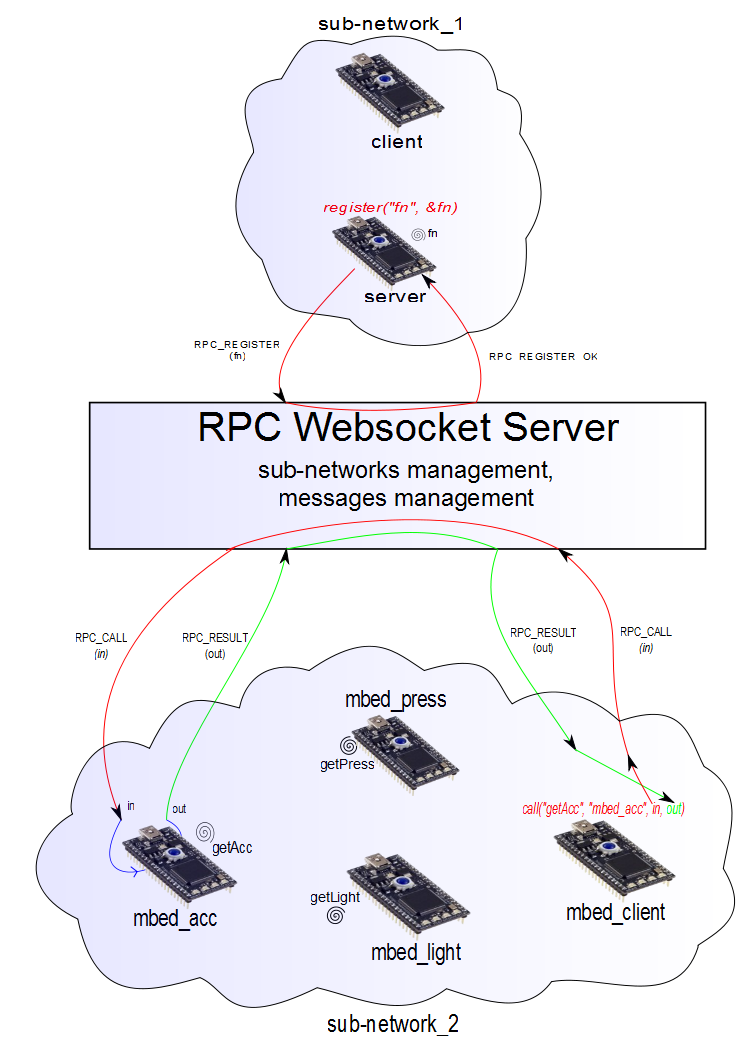Mbed RPC server
General Idea
To make the RPC possible, all Mbeds have to be connected on the same network. I have chosen to connect them to the Internet over a Websocket communication. If you are not familiar with Websockets, you can follow this tutorial to use them on your Mbed.
The sequence of an RPC operation: (let's suppose that you have two Mbeds: mbed_1 and mbed_2)
- mbed_1 calls a local method with parameters for the non local one.
- This call function packs the parameters, the name of the function to be executed,... into a message and sends it to mbed_2
- mbed_2 receives this message, decodes it, executes the function and sends to mbed_1 a new message containing the result of the function execution.
- mbed_1 receives the previous message and can handle the results of the non-local function.
All exchanged messages are in JSON format.
Example of architecture

On this diagram, you can distinguish two main elements:
- Two different sub-networks. On each sub-networks, all Mbeds can share methods or execute a non-local one.
- A RPC Websocket server which is responsible to manage all sub-networks and all messages exchanged. This server is written in Python and uses Tornado.
Information
You can take a look to this tutorial concerning the setting up of a such server but it's not necessary to follow this tutorial.
Method registering step
The first sub-network (at the top) explains the method registering step with the help of the register method.
Function signature
You can only register methods or procedures with the following signature:
void fn(MbedJSONValue& in, MbedJSONValue& out).
The MbedJSONValue type is explained in the next section of this document.
After this step, the client can call this method.
Call step
The second sub-network (at the bottom) is more interesting. It describes a call step. There are four different Mbeds:
- mbed_acc where a method getAcc has been successfully registered (these method returns values from accelerometers connected to the Mbed)
- mbed_light with a method getLight which returns the light level
- mbed_press with a method getPress which returns the pressure value
- mbed_client
mbed_client calls the function "call" where:
- "getAcc" is the name of the distant function
- "mbed_acc" is the name of the distant Mbed on the sub-network (where will be executed the method)
- in represents the arguments to be passed to the distant method
- out will be the results of the distant method execution
On this example, after the call step, mbed_client can handle accelerometers values returned by the method getAcc.
Connection to the Websocket server
Information
There is an existing Websocket server (on an Mbed server ;)). So you don't need to set up your own server.

Type of parameters: MbedJSONValue type
In the previous section, in and out parameters are represented by a specific object: MbedJSONValue. Let's suppose that getAcc doesn't take argument but returns an array of three Integers (acceleration on x, y and z).
The code for this method can be (on mbed_acc):
void getAcc(MbedJSONValue& in, MbedJSONValue& out) {
//reading accelerometers values
int readings[3] = {0, 0, 0};
accelerometer.getOutput(readings);
//store the previous values in the out parameter (the in parameter is ignored)
out[0] = readings[0];
out[1] = readings[1];
out[2] = readings[2];
}
And on mbed_client, there is something like:
//in parameter dosn't need to be filled as getAcc ignores it
MbedJSONValue in, out;
//call the non-local method
rpc.call("getAcc", "mbed_acc", in, out));
//print accelerometers values stored in the out parameter
printf("acc_x: %d\r\n", out[0].get<int>());
printf("acc_y: %d\r\n", out[1].get<int>());
printf("acc_z: %d\r\n", out[2].get<int>());
For more information on the MbedJSONValue type, please take a look to the MbedJSONValue description.
Please log in to post comments.
